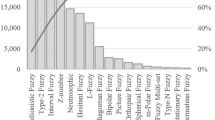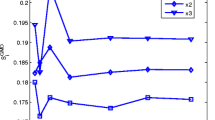Abstract
Global sensitivity analysis (GSA) is useful to recognize important inputs for assigning priority and unimportant inputs for simplifying models by exploring whole distribution ranges. Meanwhile, regional sensitivity analysis (RSA) is also studied for finding the contribution of the critical region of an input, which can be viewed as the complementary of GSA. However, there is a lack of GSA and RSA research in presence of fuzzy uncertainty. Thus, a new global sensitivity index (GSI) under the fuzzy uncertainty is devoted on the credibility distribution function (CrDF), a comprehensive distribution description under the fuzzy uncertainty. The CrDF-based GSI is defined by the fuzzy expectation of the difference between the CrDF and the conditional CrDF of the output on fixing the fuzzy input over its whole distribution range, which can quantify the contribution of the fuzzy input to the output CrDF. Then, a new fuzzy RSA technique, the contribution to this CrDF based index (shortened by CCI) plot, is also proposed, and it can assess the effect of given regions of important inputs on output CrDF. Besides, mathematical properties of the CrDF based GSI and the CCI plot are discussed, and their solution are established by use of the fuzzy simulation with the same set of samples. After the accuracy of established fuzzy simulation solution for the CrDF based GSI and the CCI plot are verified by an analytical example, other examples are used to demonstrate the reasonability and applicability of proposed CrDF based GSI and CCI plot under fuzzy uncertainty.


















Similar content being viewed by others
References
Saltelli A, Ratto M, Andres T, Campolongo F (2008) Global sensitivity analysis: the primer. Wiley, Chichester
Cheng K, Lu ZZ, Ling CY, Zhou ST (2020) Surrogated-assisted global sensitivity analysis: an overview. Struct Multidiscip Optim 61(3):1187–1213
Sobol’ IM (2001) Global sensitivity indices for nonlinear mathematical models and their Monte Carlo estimates. Math Comput Simul 55:271–280
Saltelli A (2002) Sensitivity analysis for importance assessment. Risk Anal 3(22):579–590
Kucherenko S, Song SF, Wang L (2019) Quantile based global sensitivity measures. Reliab Eng Syst Saf 185:35–48
Borgonovo E (2007) A new uncertainty importance measure. Reliab Eng Syst Saf 92(6):771–784
Liu Q, Homma T (2010) A new importance measure for sensitivity analysis. J Nucl Sci Technol 47(1):53–61
Cui LJ, Lu ZZ, Zhao XP (2010) Moment-independent importance measure of basic random variable and its probability density evolution solution. Sci China Technol Sci 53(4):1138–1145
Li LY, Lu ZZ, Feng J, Wang B (2012) Moment-independent importance measure of basic variable and its state dependent parameter solution. Struct Saf 38:40–47
Yun WY, Lu ZZ, Zhang Y, Jiang X (2018) An efficient global reliability sensitivity analysis algorithm based on classification of model output and subset simulation. Struct Saf 74:49–57
Kucherenko S, Rodriguez-Fernandez M, Pantelides C, Shah N (2009) Monte Carlo evaluation of derivative based global sensitivity measures. Reliab Eng Syst Saf 94(7):1135–1148
Song SF, Zhou T, Wang L, Kucherenko S, Lu ZZ (2019) Derivative-based new upper bound of Sobol’ sensitivity measure. Reliab Eng Syst Saf 187:142–148
Wei PF, Lu ZZ, Wu DQ, Zhou CC (2013) Moment-independent regional sensitivity analysis: application to an environmental model. Environ Model Softw 47:55–63
Tarantola S, Kopustinskas V, Boladolavin R, Kaliatka A, Uspuras E, Vaisnoras M (2012) Sensitivity analysis using contribution to sample variance plot: application to a water hammer model. Reliab Eng Syst Saf 99:62–73
Bolado-Lavin R, Castaings W, Tarantola S (2009) Contribution to the sample mean plot for graphical and numerical sensitivity analysis. Reliab Eng Syst Saf 94:1041–1049
Li LY, Lu ZZ (2013) Regional importance effect analysis of the input variables on failure probability. Comput Struct 125:74–85
Zadeh LA (1978) Fuzzy sets as a basis for a theory of possibility. Fuzzy Sets Syst 1(1):3–28
Dubois D, Prade H (1988) Possibility theory: an approach to computerized processing of uncertainty. Plenum Press, New York
Wang L, Lu ZZ, Jia BX (2020) A decoupled method for credibility-based design optimization with fuzzy variables. Int J Fuzzy Syst 22:844–858
Liu B (2002) Uncertainty theory, 2nd edn. Springer, Berlin
Ling CY, Lu ZZ, Feng KX (2019) An efficient method combining adaptive Kriging and fuzzy simulation for estimating failure credibility. Aerosp Sci Technol 92:620–634. https://doi.org/10.1016/j.ast.2019.06.037
Gauger U, Turrin S, Hanss M (2008) A new uncertainty analysis for the transformation method. Fuzzy Sets Syst 159(11):1273–1291
Song SF, Lu ZZ, Cui LJ (2012) A generalized Borgonovo’s importance measure for fuzzy input uncertainty. Fuzzy Sets Syst 189(1):53–62
Shi Y, Lu ZZ, Zhou YC (2018) Global sensitivity analysis for fuzzy inputs based on the decomposition of fuzzy output entropy. Eng Optim 50(6):1078–1096
Wang JQ, Lu ZZ, Shi Y (2018) Aircraft icing safety analysis method in presence of fuzzy inputs and fuzzy state. Aerosp Sci Technol 82–83:172–184. https://doi.org/10.1016/j.ast.2018.09.003
Liu B, Liu YK (2002) Expected value of fuzzy variable and fuzzy expected value models. IEEE Trans Fuzzy Syst 10:445–450
Liu B (2012) Membership functions and operational law of uncertain sets. Fuzzy Optim Decis Making 11:387–410
Medasani S, Kim J, Krishnapuram R (1998) An overview of membership function generation techniques for pattern recognition. Int J Approx Reason 19(3–4):391–417
Wang C, Martthies HG, Qiu ZP (2017) Optimization-based inverse analysis for membership function identification in fuzzy steady-state heat transfer problem. Struct Multidiscip Optim 57(4):1495–1505
Acknowledgements
The support by the National Natural Science Foundation of China (Project 52075442 and 11702281) and National Science and Technology Major Project (2017-IV-0009-0046) are gratefully acknowledged.
Author information
Authors and Affiliations
Corresponding author
Ethics declarations
Conflict of interest
All the authors declare that they have no conflict of interest.
Additional information
Publisher's Note
Springer Nature remains neutral with regard to jurisdictional claims in published maps and institutional affiliations.
Appendices
Appendix 1: Regular membership function
A membership function \(\rho_X (x)\) is said to be regular if there exists a point \(x_0\) such that \(\rho_X (x_0 ) = 1\) and \(\rho_X (x)\) is unimodal about the mode \(x_0\) [27]. That is, \(\rho_X (x)\) is increasing on \(( - \infty , \, x_0 ]\) and decreasing on \([x_0 , + \infty )\). Commonly used regular fuzzy distributions and their characteristics are listed in Table
6.
Appendix 2: Independent conditions for fuzzy variables
The independent conditions for the fuzzy variables are different from these of the random variables. And for the sake of helping readers to have a better understand of the independence of the fuzzy variables, this subsection illustrates the independent conditions for the fuzzy variables.
-
1.
The fuzzy variables \({\varvec{X = }}\left\{ {X_1 ,X_2 , \ldots ,X_n } \right\}^{\varvec{T}}\) are said to be independent if \({\text{Cr}}\left\{ {\bigcap\nolimits_{i = 1}^n {\{ x_i \in B_i \} } } \right\} = \mathop {\min }\nolimits_{1 \le i \le n} {\text{Cr}}\left\{ {x_i \in B_i } \right\}\) for any sets \(B_i \ \ (i = 1,2, \ldots ,n)\) of \(R\) (\(R\) is the real number space) (Definition 3.17 in Ref. [20]).
-
2.
The fuzzy variables \({\varvec{X = }}\left\{ {X_1 ,X_2 , \ldots ,X_n } \right\}^{\varvec{T}}\) are said to be independent if and only if \({\text{Cr}}\left\{ {\bigcup\nolimits_{i = 1}^n {\{ x_i \in B_i \} } } \right\} = \mathop {\max }\nolimits_{1 \le i \le n} {\text{Cr}}\left\{ {x_i \in B_i } \right\}\) for any sets \(B_i \ \ (i = 1,2, \ldots ,n)\) of \(R\) (Theorem 3.23 in Ref. [20]).
-
3.
The fuzzy variables \({\varvec{X = }}\left\{ {X_1 ,X_2 , \ldots ,X_n } \right\}^{\varvec{T}}\) are said to be independent if and only if \({\text{Cr}}\left\{ {\bigcap\nolimits_{i = 1}^n {\{ x_i = x^{\prime}_i \} } } \right\} = \mathop {\min }\nolimits_{1 \le i \le n} {\text{Cr}}\left\{ {x_i = x^{\prime}_i } \right\}\) for any real numbers \(x^{\prime}_i (i = 1,2, \ldots ,n)\) with \({\text{Cr}}\left\{ {\bigcap\nolimits_{i = 1}^n {\{ x_i = x^{\prime}_i \} } } \right\} < 0.5\) (Theorem 3.24 in Ref. [20]).
-
4.
The fuzzy variables \({\varvec{X = }}\left\{ {X_1 ,X_2 , \ldots ,X_n } \right\}^{\varvec{T}}\) are said to be independent if and only if \(\rho_{{\varvec{X}}} (x_1 ,x_2 , \ldots ,x_n ) = \mathop {\min }\nolimits_{1 \le i \le n} \left\{ {\rho_{X_i } (x_i )} \right\}\) for any real numbers \(x_i \ (i = 1,2, \ldots ,n)\) (Theorem 3.25 in Ref [20].).
Appendix 3: Proof of non-decreasing property of the CCI
According to the basic theorem of credibility distribution function (CrDF) shown in Ref. [20], CrDF \(\tilde{F}_X (x)\) is an increasing function with \(\mathop {\lim }\nolimits_{x \to - \infty } \tilde{F}_X (x) \le 0.5 \le \mathop {\lim }\nolimits_{x \to + \infty } \tilde{F}_X (x)\). Correspondingly, the inverse CrDF \(\tilde{F}_X^{ - 1} (q)\) is also an increasing function based on the inverse function theorem. Since \(\tilde{F}_{X_i }^{ - 1} (q)\) increases with the increase of \(q\), the realization of regional indicator function \(I_q (x_i )\) is more likely to be 1 when q increases.
Because the denominator of \(CCI_i \left( q \right)\) is a constant when the membership function of \(X_i\) is given, only the dominator \(\tilde{E}_{X_i } (I_q (X_i )s(X_i ))\) is discussed here. Since \(s(X_i ) \ge 0\) always holds,, \(\tilde{E}_{X_i } (I_q (X_i )s(X_i ))\) can be expressed as Eq. (25) based on the definition of fuzzy expectation.
where \(\{ x_i^{(1)} ,x_i^{(2)} ,\ldots,x_i^{(N)} \}\) are samples of \(X_i\), which are uniformly generated in its membership interval.
Assume \(q_1 < q_2\), and corresponding regional indicator functions are \(I_{q_1 } (X_i )\) and \(I_{q_2 } (X_i )\) respectively. Then, the samples satisfying \(I_{q_1 } (x_i^{(k)} )s(x_i^{(k)} )\; \ge r\) are denoted by \({{\varvec{S}}}_1^{q_1 }\) and the samples satisfying \(I_{q_1 } (x_i^{(k)} )s(x_i^{(k)} )\; < r\) are denoted by \({{\varvec{S}}}_2^{q_1 }\). Similarly, the samples satisfying \(I_{q_2 } (x_i^{(k)} )s(x_i^{(k)} )\; \ge r\) are denoted by \({{\varvec{S}}}_1^{q_2 }\) and the samples satisfying \(I_{q_2 } (x_i^{(k)} )s(x_i^{(k)} )\; < r\) are denoted by \({{\varvec{S}}}_2^{q_2 }\). For an arbitrary value of \(r\), it is not hard to find that \({{\varvec{S}}}_1^{q_1 } \subset {{\varvec{S}}}_1^{q_2 }\) and \({{\varvec{S}}}_2^{q_2 } \subset {{\varvec{S}}}_2^{q_1 }\) because \(\sum_{k = 1}^N {I_{q_1 } (x_i^{(k)} )} \le \sum_{k = 1}^N {I_{q_2 } (x_i^{(k)} )}\). So \(\mathop {\max }\nolimits_{x_i \in {{\varvec{S}}}_1^{q_{_1 } } } \left\{ {\rho_{X_i } (x_i )\;} \right\} \le \mathop {\max }\nolimits_{x_i \in {{\varvec{S}}}_1^{q_{_2 } } } \left\{ {\rho_{X_i } (x_i )\;} \right\}\) and \(\mathop {\max }\nolimits_{x_i \in {{\varvec{S}}}_2^{q_{_1 } } } \left\{ {\rho_{X_i } (x_i )\;} \right\} \ge \mathop {\max }\nolimits_{x_i \in {{\varvec{S}}}_2^{q_{_2 } } } \left\{ {\rho_{X_i } (x_i )\;} \right\}\) always hold for any r. Finally, considering the property of integral in Eq. (25), \(\tilde{E}_{X_i } (I_{q_1 } (X_i )s(X_i )) \le \tilde{E}_{X_i } (I_{q_1 } (X_i )s(X_i ))\) and \(CCI_i \left( {q_1 } \right) \le CCI_i \left( {q_2 } \right)\) subsequently, which can prove \(CCI_i \left( q \right)\) is a strict non-decreasing function of q.
Rights and permissions
About this article
Cite this article
Wang, L., Zhang, X., Li, G. et al. Credibility distribution function based global and regional sensitivity analysis under fuzzy uncertainty. Engineering with Computers 38 (Suppl 2), 1349–1362 (2022). https://doi.org/10.1007/s00366-020-01271-w
Received:
Accepted:
Published:
Issue Date:
DOI: https://doi.org/10.1007/s00366-020-01271-w




